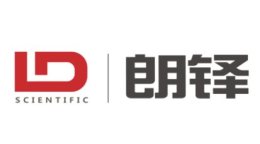Numismatic App Note_2013Dec6中Numismatic App Note_2013Dec6检测方案(能散型XRF)
检测样品 其他
检测项目 Numismatic App Note_2013Dec6
参考标准 HJ 777-2015 空气和废气 颗粒物中金属元素的测定 电感耦合等离子体发射光谱法

 白金会员
90 篇解决方案
白金会员
90 篇解决方案
方案详情文
智能文字提取功能测试中
Adding Value to the Numismatic Professionwith Portable XRF The word Numismatics comes from Latin origin and means the study orcollections of coins, tokens, paper money, and sometimes related objects(such as medals)1. When discussing the value of coins it is importantto distinguish between the bullion value of a coin (i.e. the coin’s valuebased on its precious metal content) and its numismatic value. Coins withnumismatic value (“numismatic coins”), are collectible coins valued for theirage and rarity rather than, or in addition to their precious metal content.Numismatic coins are typically sold to and traded among collectors, whomay be interested in them for their historical, cultural, or investment value.They may be purchased from wholesalers, national and local retail outletsand brokers, and certification labs. Application There have been several interesting developments andtrends taking place in the world of numismatics, butunfortunately, not all of them are positive. In recent yearscounterfeiting has become a pervasive issue in thenumismatics marketplace. Counterfeiters are becoming soskilled at replicating the weight, appearance, and strikecleanliness of real coins that high quality fakes can easilybe passed off as genuine products. The numismatic markethas become risky for investors who may be dealing withuntrained brokers, lacking in advanced analyticaltechnologies, or simply unscrupulous. As a result of increased fraudulent activities we may seethe numismatic market become more regulated inresponse to numerous consumer complaints aboutcounterfeit coin scams. The recently enacted MinnesotaSenate Bill 3822, for example, calls for numismaticsdealers to disclose in writing the exact precious metalcontent of the coins they sell, with penalties for failing todo so,or for misleading the buyer about the compositionof the coins. Dealers will also face consequences formisrepresenting their qualifications to evaluate coins, andfor failing to comply with agreed upon terms of sale. If theMinnesota law proves successful, other states will likely follow suit. Furthermore, numismatics are more oftenbeing promoted as an investment rather than collector’sitems, which may eventually lead to government oversightof the bullion coin market in a manner similar to thestock and bond markets. Such industry shifts point to anincreasing need for highly sophisticated analyticaltechnologies to verify the precious metal content ofnumismatics. Coin collectors and dealers utilize various methods toanalyze their coins, including analytical and non-analyti-cal methods. Non analytical methods involve examiningthe overall presentation of the coin with simple tools suchas a loupe or a magnifying glass. The mint year, anysurface alterations, special marks, visible damages willoften provide information regarding the general conditionof the coin and its authenticity. Other non-analyticaltesting methods include a ping test, in which the coin isstruck with a piece of metal; based on the sound reflected,information can be ascertained as to whether a coin isalloyed or consists of a high concentration of gold orsilver (the pure, or near-pure gold will make a dull,non-lasting sound, whereas pure silver produces asustained ring). Analytical testing methods include the usage of electricalconductivity devices for gold content measurements.These devices take advantage of the fact that gold is anexcellent electrical conductor, and therefore measuringthe electrical conductivity of a coin can provide informa-tion regarding its precious metal content. This method istypically restricted to the measurement of just a fewmetals, typically Au (gold) and Pt (platinum). Unfortu-nately, the Ag (silver) content - which is of high interestto numismatics professionals -cannot be detected byelectrical conductivity testers, nor can they provide clearindication of the presence of any alloying metals such ascopper or zinc. So typically they provide only qualitativeresults. These devices are also prone to false readings dueto cross-contaminations of the testing probes Acid tests are often used to determine the Au karat-valueof a coin. Acid tests, by their nature, are qualitative andhave limited accuracy. The tests work by applying aseries of acids to determine specific karat value ranges,namely 10k, 14k, 18k, and 22k. Based on chemicalreactions that take place, or the lack of thereof, the usermay conclude that the karat value of a coin or jewelryitem lies within a certain range, e.g.,“above 14k andbelow 18k". What the test does not reveal is the actualgold concentration, the existence and concentration ofother precious metals or alloying elements, or anyindication of gold plating. The acid test is also destruc-tive and by no means is acceptable when it comes toevaluating high-value numismatic coins. The acids used.are corrosive and require special protection. Regardless of the method used to evaluate coins, there is agreat value in avoiding any damage to a collectable coinas this may diminish its value by thousands of dollars incertain cases. X-ray fluorescence (XRF) instrumentationsuch as the Thermo Scientific Niton DXL and Niton XL2XRF precious metal analyzers provide a fast, accurate,and most importantly, nondestructive alternative forassessing the metal composition of coins, and are cur-rently used by numismatic professionals. We will take a look at a few examples and see how thispowerful tool can be used to detect numismatic fraud andincrease the operational speed and efficiency for coincollectors and dealers: Verification of Elemental Composition-Many coinseries are characterized by a unique elemental signature,meaning that the amount and type of certain elements areclearly defined. Any deviation from this compositionwould indicate fraud. As an example, Canadian dimes andquarters have well-defined compositions. In the year 1968the composition changed from a 50% Ag (silver) / 50%Ni (nickel) to a 99% Ni composition. Under normalcircumstances, the minting year would have served as areliable indication for the composition, however, in thiscase, the composition-change occurred in mid year. Giventhe similar appearance of the two coins,this implies thatcollectors have no means to assign a clear composition tocoins that were minted in that year. The value differencebetween the two compositions is $0.76. With the help ofportable XRF technology,the precious metal content canbe reliably quantified within seconds. Bulk Analysis of Coins-Coin dealers will frequently examine coins in bulk quantities. The coins are oftendelivered to the shop in wraps or plastic bags andtransactions have to be concluded quickly. Analyzing eachand every coin by examining its mint year can be atedious, eye-constraining, distracting, and time-consumingtask. With the help of portable XRF analyzer, this task canbe reduced to a fraction of the time - without having toremove the coins from the wrappers or bags in which theywere delivered. Gold Plating Detection - Certain gold coins come invarious purity levels. The purity level can vary between14K and 22K, and, in addition, they can come in Au-plated or unplated versions. While the unaided eye candistinguish between a medium-karat (e.g.,14K) and ahigh-karat coin (22K), it is difficult to distinguish betweena high-karat and a gold-plated coin. Destructive tests arehighly discouraged, as they will significantly diminish thevalue of the coin. Thanks to Thermo Fisher Scientific’spatented AuDITTM gold-plating detection technology, any gold plating or the lack of thereof can be reliably deter-mined in a matter of seconds. Fraud Detection-Fake coins are flooding the markets!The methods used by counterfeiters are becoming moreand more advanced. A common method to fake coins is toapply a silver plating to a non-silver substrate, in an effortto imitate a solid silver coin. Portable XRF can easilydetect the composition of the coin revealing any devia-tions from the original coin’s known composition. Ademonstration by a numismatic expert in a popularYouTube video demonstrates the prowess of our NitonXL2 precious metal analyzer in the process of detectingsuch fraudulent coinst. Direct Measurement of Encapsulated Coins-Valu- able coins are often protected by thin foils or encapsulatedin plastic slabs, such as the one shown in the photo at theupper left of the page. This is done in order to retain thecoin’s value; removing the coin from its protective coverdiminishes its value instantly (it’s like driving a brand newcar out of the dealership minutes after the purchase, thecar’s value drops as soon as it leaves the dealership).. Counterfeiters will often take advantage of this andenclose a fake coin in a protective sheet, assuming andhoping that the buyer is not likely to open it. PortableXRF can easily detect the true composition of the coin bytesting through thin foil covers, and provide a very goodindication of the coin’s composition even in the case ofthicker plastic slabs. Measuring a silver coin twice using the Thermo ScientificNiton DXL, once through a protective foil, and oncewithout the foil, showed the following results: Element Without Plastic Foil With Plastic Foil Ag 88.3±1.1 87.4±1.1 Cu 11.7±0.4 12.5±0.4 Conclusion X-ray fluorescence (XRF) analyzers provide a fast, accurate, nondestructive method to aid in assessing the value ofcollectable coins. XRF analyzers help coin dealers detect fraud and increase their overall operational efficiency becausethey quickly provide the exact karat weight and percentages of all precious metals and alloying elements within an item- easily identifying non-standard, under-karated, and even advanced counterfeit material that acid testing is incapable ofdifferentiating. What’s more, our AuDIT technology helps identify gold-plated items that may go undetected by moretraditional test methods. Additional Information/Resources: American Numismatic Society-www.numismatics.org American Numismatic Association -www.money.org Independent Coin Graders (“ICG”)- http://www.icgcoin.com/ ANACS (grading services)- http://www.anacs.com/Default.aspx. New Minnesota Bill- http://legiscan.com/MN/text/SF382/id/798143www.coinflation.com/ ( 1 Merriam Webster Onli n e Dictionary ) 2http://legiscan.com/MN/text/SF382/id/798143 ( 3 http://www.coinflation.com/, August2013. 4 http://goldsilver.com/video/special-report-how-to-avoid-fake-silver-and-counterfeit-gold-products/ ) 5 Measurement time: 10s, average from three measurements, small spot activated thermoscientific.com/niton C 2013 Thermo Fisher Scientific Inc. All rights reserved. All trademarks are the property of Thermo Fisher Scientific Inc. and its subsidiaries. Specifications,terms and pricing are subject to change. Not all products are available in all countries. Please consult your local sales representative for details. Americas Europe, Middle East, Asia PacificBoston, MA USA Africa & South Asia New Territories, Hong Kong+1978 670 7460 Munich, Germany +85228854613niton@thermofisher.com +49 89 3681 380 niton.asia@thermofisher.comniton.eur@thermofisher.com In addition to these offices, Thermo Fisher Scientific maintains a network of representative organizations throughout the world. The word Numismatics comes from Latin origin and means the study or collections of coins, tokens, paper money, and sometimes related objects (such as medals)1. When discussing the value of coins it is important to distinguish between the bullion value of a coin (i.e. the coin’s value based on its precious metal content) and its numismatic value. Coins with numismatic value (“numismatic coins”), are collectible coins valued for their age and rarity rather than, or in addition to their precious metal content. Numismatic coins are typically sold to and traded among collectors, who may be interested in them for their historical, cultural, or investment value. They may be purchased from wholesalers, national and local retail outlets and brokers, and certification labs.
关闭-
1/4
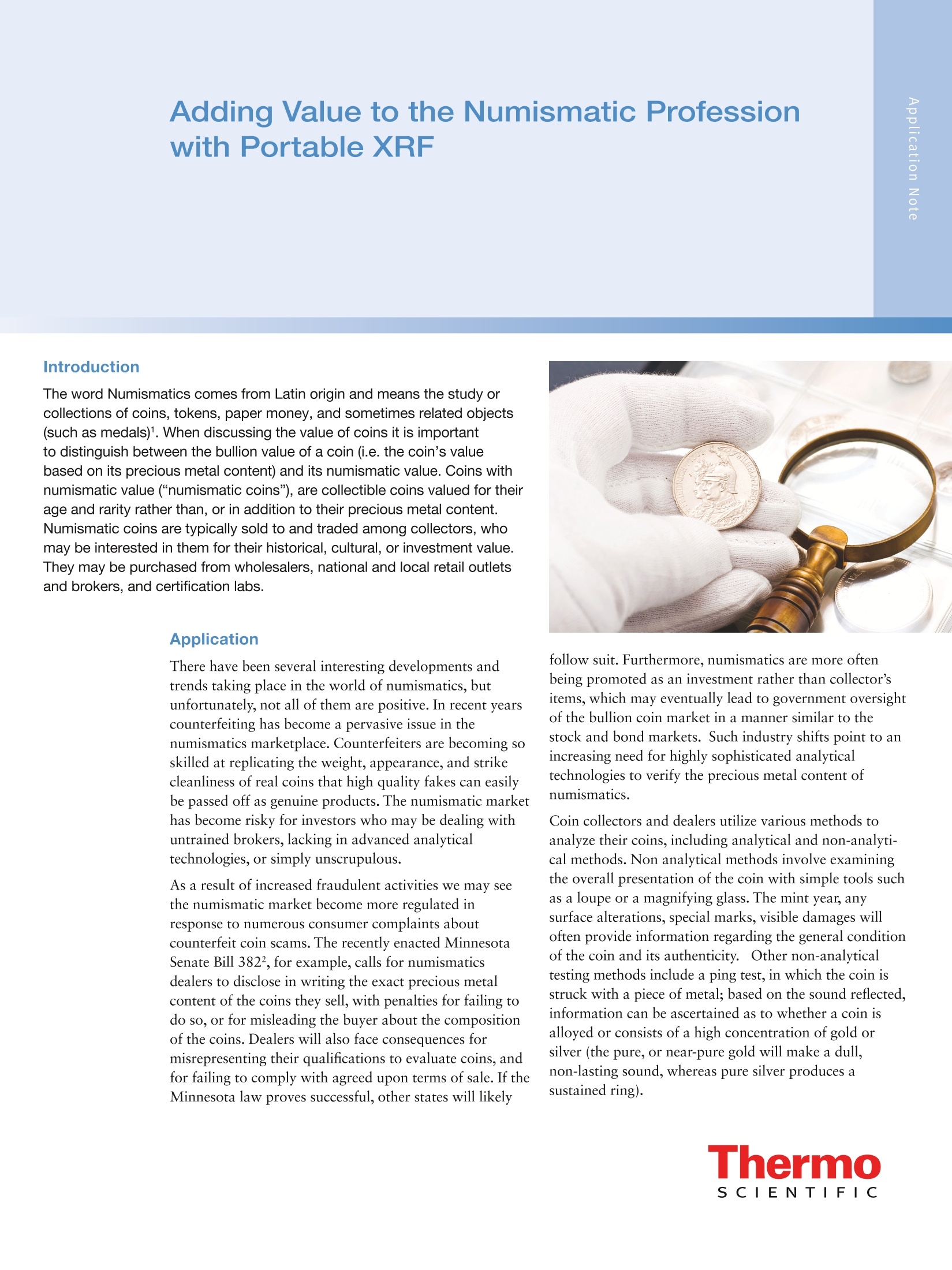
-
2/4
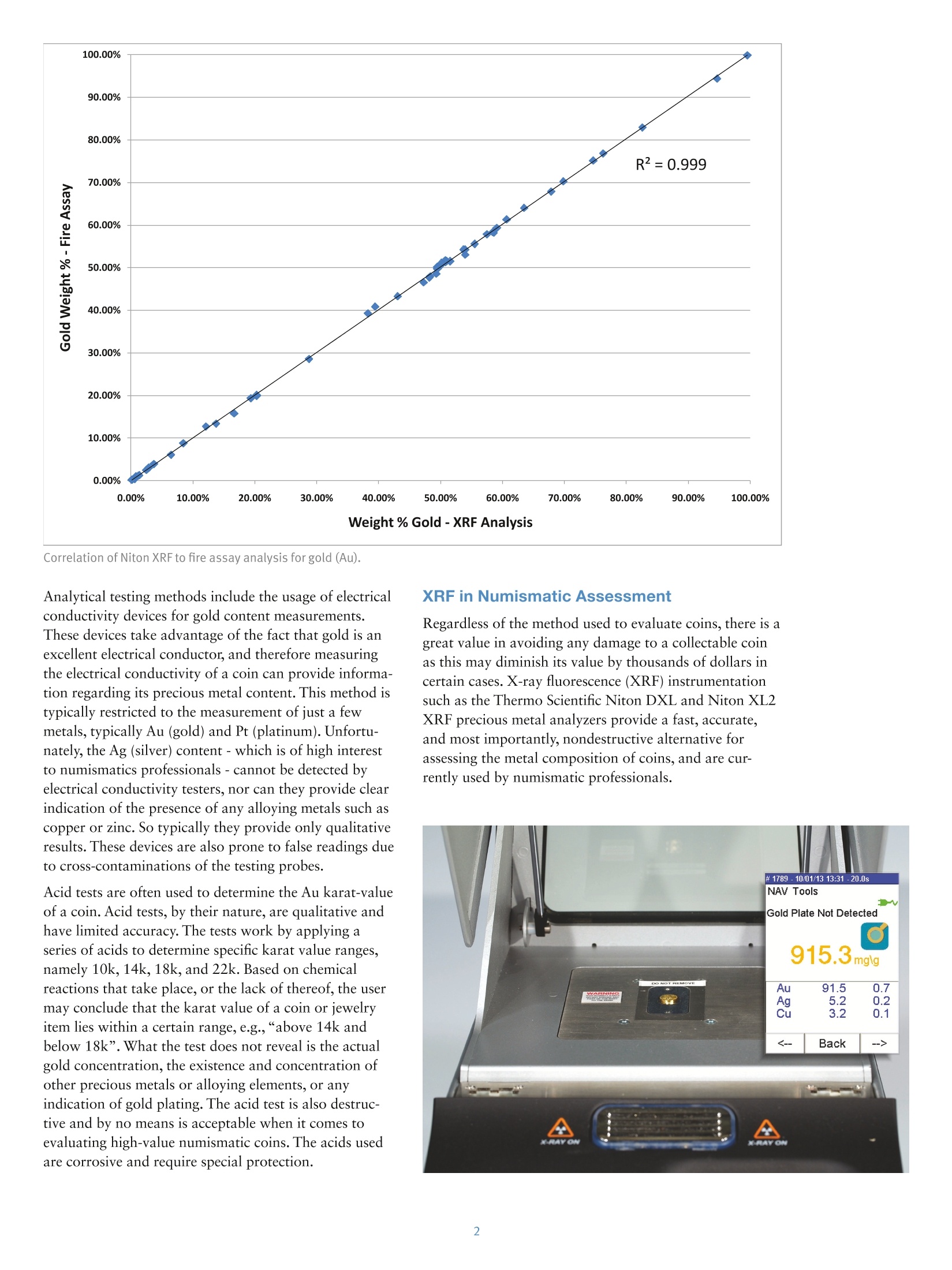
还剩2页未读,是否继续阅读?
继续免费阅读全文产品配置单
朗铎科技(北京)有限公司为您提供《Numismatic App Note_2013Dec6中Numismatic App Note_2013Dec6检测方案(能散型XRF)》,该方案主要用于其他中Numismatic App Note_2013Dec6检测,参考标准《HJ 777-2015 空气和废气 颗粒物中金属元素的测定 电感耦合等离子体发射光谱法》,《Numismatic App Note_2013Dec6中Numismatic App Note_2013Dec6检测方案(能散型XRF)》用到的仪器有Niton XL5 PLUS手持式合金分析仪。
我要纠错
推荐专场
X荧光光谱、XRF(能量色散型X荧光光谱仪)
更多相关方案

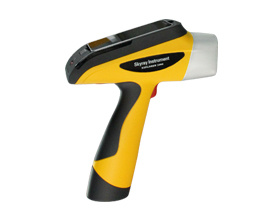
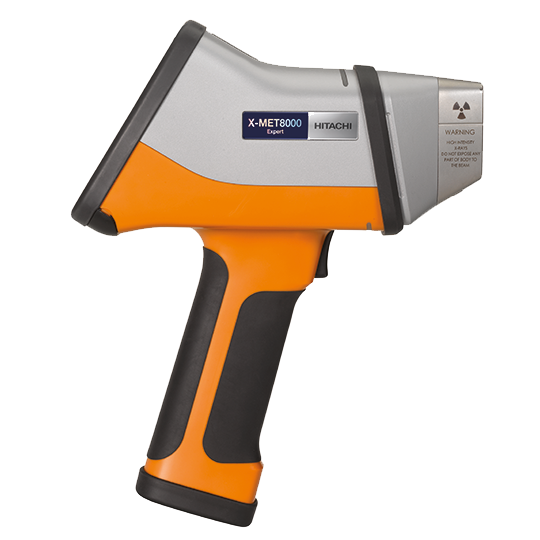

 咨询
咨询